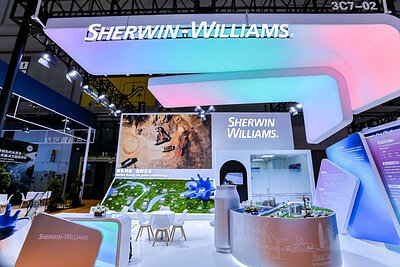
Sherwin-Williams Paints a Sustainable Future in China with Tech & Tradition
At the China International Import Expo, Sherwin-Williams unveils innovative, eco-friendly coatings & a commitment to Chinese cultural heritage, signaling a strategic bet on the growing market.
Sherwin-Williams Paints a Sustainable Future in China with Tech & Tradition
Shanghai, China – Sherwin-Williams, a global leader in paints and coatings, is making a significant push into the Chinese market, unveiling a portfolio of sustainable technologies and a unique cultural initiative at the China International Import Expo (CIIE) this week. Beyond simply expanding its footprint, the company appears to be strategically aligning itself with China’s ambitious environmental goals and rich cultural heritage.
This marks Sherwin-Williams’ debut at CIIE, and the company is showcasing a range of innovations designed to reduce environmental impact and meet the evolving demands of a rapidly growing industrial sector. Central to this strategy are advancements in low-VOC coatings, powder technology, and circular economy initiatives.
Innovation at the Forefront
The company is highlighting several new products, including Heat Flex AEB, an engineering-grade thermal insulation and anti-corrosion coating designed to minimize downtime in harsh industrial environments. Also featured is OneCure™, a powder coating technology promising superior edge protection and corrosion resistance, and Powdura® EV Insulation Powder, designed specifically for the burgeoning new energy vehicle (EV) battery market. Rounding out the new offerings is Duraspar® High Performance Series, a high-solids, low-VOC coating for heavy equipment and energy applications.
“The Chinese market is increasingly focused on sustainability and performance,” explains a company spokesperson. “Our new products are designed to deliver both, helping our customers reduce their environmental footprint and improve operational efficiency.”
These innovations align with China’s stringent environmental regulations, particularly the push to reduce volatile organic compound (VOC) emissions. According to industry research, the Chinese coatings market, valued at $35.2 billion in 2024, is expected to grow at a robust 6.8% annually through 2030. However, growth is increasingly tied to environmentally friendly products.
Beyond Green Tech: A Cultural Bridge
Sherwin-Williams is differentiating itself not only through technological innovation but also through a conscious effort to connect with Chinese culture. The company's CIIE exhibit features a short film, “Colors of Heritage: Sherwin-Williams in China,” showcasing the artistry of traditional Chinese lacquerware and the restoration of a Ming Dynasty temple using the company’s coatings.
“We wanted to demonstrate our respect for Chinese heritage and highlight the parallels between traditional craftsmanship and modern coating techniques,” a company representative stated. “It’s about building trust and long-term relationships.”
This cultural approach appears to be resonating with local experts. “Sherwin-Williams is taking a rare approach by blending innovation with cultural sensitivity,” noted a cultural heritage expert who wished to remain anonymous. “This approach has the potential to strengthen brand loyalty in the Chinese market.”
Navigating a Competitive Landscape
Despite the promise, Sherwin-Williams faces a competitive landscape dominated by established players such as PPG Industries, AkzoNobel, and Nippon Paint. While currently holding approximately 8% of the Chinese market, lagging behind Nippon Paint (22%) and AkzoNobel (15%), the company is strategically targeting high-growth segments like industrial coatings and EV battery technology.
“The Chinese coatings market is intensely competitive,” explains an industry analyst. “Sherwin-Williams needs to differentiate itself not only through product innovation but also through strong partnerships and localized marketing efforts.”
A Commitment to Sustainability & Circularity
Sherwin-Williams has publicly committed to reducing its carbon emissions by 30% by 2030, a goal that aligns with China’s “Dual Carbon” goals of peaking emissions by 2030 and achieving carbon neutrality by 2060. The company’s focus on waterborne coatings – now accounting for 60% of its sales – and the integration of recycled content into products like Duraspar®, demonstrate its commitment to a circular economy.
“Sustainability is no longer just a marketing buzzword; it’s a business imperative,” says a company spokesperson. “We are committed to reducing our environmental footprint and helping our customers do the same.”
The company also benefits from government incentives supporting green technologies and participation in events like CIIE, offering potential tax breaks and streamlined customs procedures.
Looking Ahead
Sherwin-Williams’ debut at CIIE signals a long-term commitment to the Chinese market. By combining cutting-edge technology with a deep respect for local culture, the company is positioning itself for success in a rapidly evolving and increasingly competitive landscape. While challenges remain, Sherwin-Williams' focus on sustainability, innovation, and cultural sensitivity suggests that it is well-prepared to paint a sustainable future in China.
